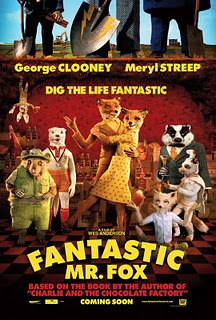After hearing repeatedly that Fantastic Mr. Fox is Wes Anderson’s best film, I gave it a try. I’m not the biggest Anderson fan—I generally find his aesthetic too precious, his characters over-privileged bores, and his daddy issues repetitive and tiresome—but it seemed to me that stop-motion animation might be the ideal medium to capture his intentions.
is Wes Anderson’s best film, I gave it a try. I’m not the biggest Anderson fan—I generally find his aesthetic too precious, his characters over-privileged bores, and his daddy issues repetitive and tiresome—but it seemed to me that stop-motion animation might be the ideal medium to capture his intentions.
And, before I say anything else, let me say that the look of the film was great. It was fittingly retro and playful for (an overgrown man-child like) Anderson and (the all-style-no-substance preferences of) his ideal audience. The style, however, isn’t enough to garner the near universally-glowing reviews Fox has received. If you look at the film with anything other than squinty eyes and plugged ears, the problems are immediately evident.
Mrs. Fox. Meryl Streep voices the only female character in the entire cast. Okay, there’s a love interest to bat her eyelashes at the boys, but I don’t even think she had a line. Not only is the lone female character a wife and mother—seen cooking and husband-scolding more than any other activity—but also is a waste of a talented actress. Commenter gmarv on A.O. Scott’s NYT review puts it well:
Note to Wes: if your one female character (wife + mother) is supposed to be a professional artist, could you at least show her working during the DAY in her STUDIO, not cooking all day and painting outside at night with her kid and husband sitting around her?It’s disappointing that this film incorporates Dahl’s lack of interest in women (that veers close to misogyny). I guess it’s not that much different from other Wes Anderson films that way…but with a little more imagination it could have been so much better.
“Lack of interest in women” seems to put it mildly. Anderson’s films do typically have problems with—and lack of (interest in)—women (the topless intern from The Life Aquatic comes to mind). But, not a single one of the creatures in the big plot to save the Fox family could have been female? Seriously?
While I’m not typically a stickler for accurate adaptations, Amy Biancolli of The Houston Chronicle points out some poignant changes from Roald Dahl’s novel:
1) In the original, Mrs. Fox was complicit all along. 2) Mr. Fox never went on the wagon. 3) Mr. and Mrs. Fox had four cubs, not one little nutcase, and Dahl made no mention of a yoga-bending super-nephew. 4) I’m pretty sure the point of the story wasn’t Mr. Fox’s flagging self-esteem or his strained relationship with his son. But this is cinema in the time of Oprah, when Reductio ad navelgazing is the inevitable narrative arc.
Wouldn’t Mrs. Fox have been so much more interesting and dynamic if she hadn’t been the domesticating, shaming force in the man’s (and boy’s) life? If she actually remained a person after marrying and having a child, who struggles with being a “wild animal” too? The tiny (ha) complication of keeping Mrs. Fox complicit would have done wonders for the story.
Wouldn’t it also have been great if Anderson—who, despite all my negative comments, does have directorial talent—had changed course just a little bit and not made a movie about a strained father-son relationship? Talent grows only when it’s challenged, and perhaps that’s why I keep giving Anderson another chance. After Fox, though, I’m not sure he gets another shot.

